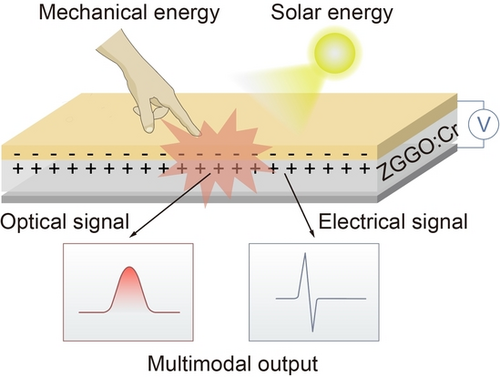Self-Powered and Self-Recoverable Multimodal Force Sensors Based on Trap State and Interfacial Electron Transfer
Graphical Abstract
Multimodal force sensor: A self-powered and self-recoverable force sensor based on trap-controlled luminescence and interfacial electron transfer is presented. The magnitude of force can be converted into electrical responses, and force distribution can be visualized by optical signals simultaneously, without any power supply and high-energy irradiation. It has promising applications in a wide range of artificial intelligence systems.
Abstract
Multi-dimensional force sensing that combines intensity, location, area and the like could gather a wealth of information from mechanical stimuli. Developing materials with force-induced optical and electrical dual responses would provide unique opportunities to multi-dimensional force sensing, with electrical signals quantifying the force amplitude and the luminescence output providing spatial distribution of force. However, the reliance on external power supply and high-energy excitation source brings significant challenges to the applicability of multi-dimensional force sensors. Here we reported the mechanical energy-driven and sunlight-activated materials with force-induced dual responses, and investigated the underlying mechanisms of self-sustainable force sensing. Theoretical analysis and experimental data unraveled that trap-controlled luminescence and interfacial electron transfer play a major role in force-induced optical and electrical output. These materials were manufactured into pressure sensor with renewable dual-mode output for quantifying and visualization of pressures by electrical and optical output, respectively, without power supply and high-energy irradiation. The quantification of tactile sensation and stimuli localization of mice highlighted the multi-dimensional sensing ability of the sensor. Overall, this self-powered pressure sensor with multimodal output provides more modalities of force sensing, poised to change the way that intelligent devices sense with the world.
Conflict of interests
The authors declare no conflict of interest.
Open Research
Data Availability Statement
The data that support the findings of this study are available from the corresponding author upon reasonable request.





